01529 304273 - [email protected]
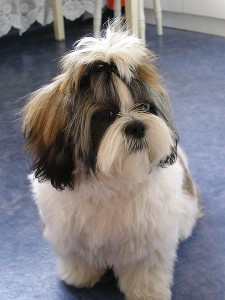 The name Shih Tzu comes from the Chinese word for “lion dog” because this kind of dog was bred to resemble “the lion as depicted in traditional oriental art,such as the Chinese guardian lions. (The Pekingese is also called “lion dog” in Chinese.) The Shih Tzu is also known as the “Xi Shi dog” because Xi Shi was regarded as one of the most beautiful women of ancient China.Shih Tzu were nicknamed the Chrysanthemum Dog in England in the 1930s.The breed can also be referred to as the Tibetan Lion Dog, but whether or not the breed should be referred to as a “Tibetan” or “Chinese” breed is a source of argument, the absolute answer to which is probably impossible to prove.
The name Shih Tzu comes from the Chinese word for “lion dog” because this kind of dog was bred to resemble “the lion as depicted in traditional oriental art,such as the Chinese guardian lions. (The Pekingese is also called “lion dog” in Chinese.) The Shih Tzu is also known as the “Xi Shi dog” because Xi Shi was regarded as one of the most beautiful women of ancient China.Shih Tzu were nicknamed the Chrysanthemum Dog in England in the 1930s.The breed can also be referred to as the Tibetan Lion Dog, but whether or not the breed should be referred to as a “Tibetan” or “Chinese” breed is a source of argument, the absolute answer to which is probably impossible to prove.
The Shih Tzu is an alert, lively, little dog. It is happy and hardy, and packed with character. The gentle, loyal Shih Tzu makes friends easily and responds well to consistent, patient training. It makes a very alert watchdog. It is courageous and clever. Playful and spunky, this affectionate little dog likes to be with people and is generally good with other pets. Some can be difficult to house train. The Shih Tzu needs all of the humans in the house to be pack leaders, with the rules of the house made consistently clear. Owners who allow their dogs to take over may find them to be snappish if they are surprised or peeved. Because of this dog’s small size and its adorable face, it commonly develops Small Dog Syndrome ( see separate article on this site), human induced behaviours where the dog believes he is the boss of humans. This causes a varying degree of behavioural issues, such as, but not limited to separation anxiety, guarding, growling, snapping, and even biting. These dogs may become untrustworthy with children and sometimes adults, as they try and tell the humans what THEY want THEM to do. They will be obstinate as they take their stand and defend their top position in the pack. They may bark obsessively as they try and TELL you what they want. These behaviours are NOT Shih Tzu traits, but rather behaviours brought on by the way they are treated by people around them.
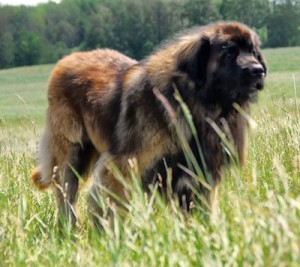 The Leonberger is a giant dog breed, and is unusual for large breed dogs in that it was developed specifically for its appearance, rather than a specific function. The breed’s name derives from the city of Leonberg in Baden-Württemberg, Germany, and was apparently bred to resemble lion in the town crest.
The Leonberger is a giant dog breed, and is unusual for large breed dogs in that it was developed specifically for its appearance, rather than a specific function. The breed’s name derives from the city of Leonberg in Baden-Württemberg, Germany, and was apparently bred to resemble lion in the town crest.
The Leonberger has a lively nature. It is brave, intelligent, steady, affectionate and calm , the Leonberger loves everyone. It is intelligent, and its loyalty and love for its family is unparalleled. A well-balanced Leonberger will be highly trustworthy and have incredible patience, even with the most obnoxious children. With most of these dogs, if the situation becomes too intense, instead of showing any aggression, the Leonberger simply walks away. They are not known to be great watchdogs. The Leonberger does not respond very well to harsh training methods; training requires patience. Owners need to be firm, but calm, confident and consistent. Often called a gentle giant, the Leonberger is serious, eager and willing to please, responding well to training. The Leonberger gets along with other dogs, but it is highly recommended that they are well socialised and trained early as this puppy will become a very large adult. Especially essential is teach your dog to respect humans by training it not to jump, to heel on the lead and to enter and exit all door and gateways after the humans.
The Leonberger sheds fur very heavily. A good brushing every week is sufficient to keep it in fine shape, except when the undercoat is being shed; then daily combing or brushing is in order for the duration of the moult.
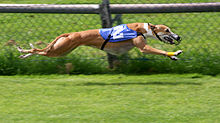 The Greyhound is a very old European breed, a sighthound which has been historically bred for coursing game and racing. Since the rise in large scale rescue of retired racing Greyhounds, it has seen a resurgence in popularity as a family pet.
The Greyhound is a very old European breed, a sighthound which has been historically bred for coursing game and racing. Since the rise in large scale rescue of retired racing Greyhounds, it has seen a resurgence in popularity as a family pet.
Greyhounds are an intelligent and gentle and intelligent breed whose combination of long, powerful legs, deep chest, flexible spine, and slim build allows it to reach average race speeds in excess of 63 kilometres per hour (39 mph)).At maximum acceleration, from a standing start, a greyhound can reach full speed within 30 metres or six strides. The only other animal that can accelerate faster over a short distance is the cheetah, which can reach speeds of 109 kilometres per hour (68 mph) over 3-4 strides from a similar standing start.
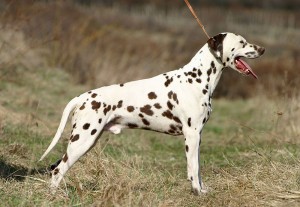 The Dalmatian (Croatian: Dalmatinac, Dalmatiner) is a breed whose roots are often said to trace back to Dalmatia (a region of Croatia).It is also known as the Carriage Dog, the Spotted Coach Dog, the Firehouse Dog and even the ‘Plum Pudding Dog’.
The Dalmatian (Croatian: Dalmatinac, Dalmatiner) is a breed whose roots are often said to trace back to Dalmatia (a region of Croatia).It is also known as the Carriage Dog, the Spotted Coach Dog, the Firehouse Dog and even the ‘Plum Pudding Dog’.
The Dalmatian is noted for its unique black- or brown-spotted coat and was mainly used as a carriage dog in its early days. Today, this dog remains a well-loved family pet, and many dog enthusiasts enter their pets into the competitions of many kennel clubs.
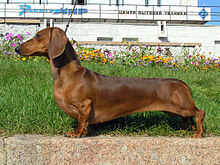 The dachshund is a short-legged, long-bodied dog belonging to the hound family. The standard size dachshund was bred to scent, chase, and flush out badgers and other burrow-dwelling animals, while the miniature dachshund was developed to hunt smaller prey such as rabbits. In the American West they have also been used to hunt prairie dogs.
The dachshund is a short-legged, long-bodied dog belonging to the hound family. The standard size dachshund was bred to scent, chase, and flush out badgers and other burrow-dwelling animals, while the miniature dachshund was developed to hunt smaller prey such as rabbits. In the American West they have also been used to hunt prairie dogs.
The Dachshund is curious, clever, lively, affectionate, proud, brave and amusing. Devoted to its family, it can be slightly difficult to train and housebreak, but not impossible. Dachshunds travel well. This little dog needs an owner who understands how to be his pack leader or he will take over the house, and begin to try and tell the owner what to do. If the dog is allowed to take over, many behaviour problems will arise, such as, but not limited to, guarding furniture, separation anxiety, guarding food, toys or other objects, snapping, biting and obsessive barking. It will become unpredictable with children and adults they do not know. If it gets really bad, it may become unpredictable with its owner. They are usually recommended for older, considerate children, simply because most owners do not display proper pack leadership to small dogs, causing moderate to severe protectiveness.
 The Akita is a large spitz breed of dog originating from the mountainous northern regions of Japan.
The Akita is a large spitz breed of dog originating from the mountainous northern regions of Japan.
In America the Akita breed consists of both the Akita Inu and the ‘American Akita. In the UK the Akita Inu has a lightly build and comes in a small selection of colours, whereas the Akita comes in a wide range of colours. In America and Cananda they are considered to be the same breed. This article ith deal with the Akita, or the American Akita rather than the Akita Inu.
Both forms of Akita are probably best known worldwide from the true story of Hachikō, a loyal Akita dog who lived in Japan before World War II. The Akita is a strong, independent and dominant breed, commonly aloof with strangers but affectionate with family members. They are known to compete in many dog competition sports, yet some are known to be intolerant of other dogs and require a knowledgeable and firm handler.As a breed, Akitas are generally hardy, but they have been known to suffer from various genetic conditions and be sensitive to certain drugs.
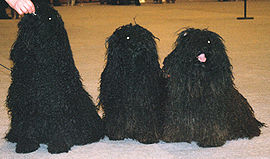 The Puli (plural Pulik) is a lively, cheerful little dog who is very loyal. It is small-medium in size, its origin lies in Hungarian herding and livestock guarding dogs and is known primarily for its long, corded coat. The tight curls of the coat, similar to dreadlocks, make it virtually waterproof. A similar looking, but much larger Hungarian breed is called Komondor.
The Puli (plural Pulik) is a lively, cheerful little dog who is very loyal. It is small-medium in size, its origin lies in Hungarian herding and livestock guarding dogs and is known primarily for its long, corded coat. The tight curls of the coat, similar to dreadlocks, make it virtually waterproof. A similar looking, but much larger Hungarian breed is called Komondor.
Puli are reasonably intelligent, agile dogs. Despite their bulky appearance and very thick coat they are very fast, agile and able to change directions instantlyand are obedient enough to train for athletic competition. They are devoted and form close bonds with their owners.
They are excellent family pets and will adapt to most surroundings and circumstances. Their innate intelligence makes them easy to train. If the Puli senses their owners are not as strong minded as themselves they will become willful with a mind of their own, as they will believe they need to make up their own rules of the home. They do very well in obedience and agility as well as in the show ring.
 Originating in Germany, the Boxer is a stocky, medium-sized, short-haired breed. The coat is smooth and tight-fitting; colours are fawn or brindled, with or without white markings, which may cover the entire body. Boxers are brachycephalic (they have broad, short skulls), and have a square muzzle, mandibular prognathism (an underbite), very strong jaws and a powerful bite ideal for hanging on to large prey. The Boxer was bred from the Old English Bulldog and the now extinct Bullenbeisser and is part of the Molosser (mastiff) group.
Originating in Germany, the Boxer is a stocky, medium-sized, short-haired breed. The coat is smooth and tight-fitting; colours are fawn or brindled, with or without white markings, which may cover the entire body. Boxers are brachycephalic (they have broad, short skulls), and have a square muzzle, mandibular prognathism (an underbite), very strong jaws and a powerful bite ideal for hanging on to large prey. The Boxer was bred from the Old English Bulldog and the now extinct Bullenbeisser and is part of the Molosser (mastiff) group.
The Boxer is happy, high-spirited, playful, curious and energetic, often referred t oas the clown of the dog world. Highly intelligent, eager and quick to learn, the Boxer is a good dog for competitive obedience. It is constantly on the move and bonds very closely with the family. Loyal and affectionate, Boxers are known for the way they get along so well with children. A well brought-up and properly socialized Boxer will also get along with his own kind and other household pets such as cats. Animals such as rodents, ducks, chickens and other farm birds may be too tempting, however, they can be taught to “leave it” but it is still not recommended they be left alone with them.
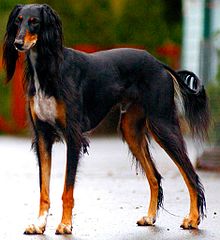 This breed has a great many names including Gazelle Hound, Arabian Hound, Persian Greyhound Tanji ,Persian Sighthound as well as the Royal Dog of Egypt. It is one of the oldest known breeds of domesticated dog. From the period of the Middle Kingdom onwards, Saluki-like animals appear on the ancient Egyptian tombs of 2134 BC. They have connections both to the Bible and Imperial China.
This breed has a great many names including Gazelle Hound, Arabian Hound, Persian Greyhound Tanji ,Persian Sighthound as well as the Royal Dog of Egypt. It is one of the oldest known breeds of domesticated dog. From the period of the Middle Kingdom onwards, Saluki-like animals appear on the ancient Egyptian tombs of 2134 BC. They have connections both to the Bible and Imperial China.
The Saluki is a sighthound and historically travelled throughout the Middle East with nomadic desert tribes over an area stretching from the Sahara to the Caspian Sea. They have been used to hunt quarry such as gazelles in the Middle East.
Saluki are gentle, friendly, even-tempered and extremely devoted dogs. They can be somewhat aloof, even with their family. This loyal dog may become very attached to one person. They are good with children who do not try and roughhouse with them. They are sensitive, and do not take kindly to harsh discipline. They must be trained with calm, gentle, but firm, consistency. They are fairly submissive by nature to people and dogs and are easily distracted. Be sure you remain the dog’s pack leader so the dog feels secure with his surroundings.
The Saluki do well with other Salukis, keeping more than one is often a good idea. They are a pleasant and calm companion and make a good watchdog. Though not aggressive with people, the Saluki’s natural instinct is to chase and kill non-canine animals. Take great caution around pets such as birds, guinea pigs, hamsters and rabbits. They can get along with family cats if the cat is allowed to assert its dominance over the dog, but may chase strange cats.
The German Shepherd Dog, also known as an Alsatian, is a breed of large-sized dog that originated in Germany.The German Shepherd is a relatively new breed of dog, with its origin dating to 1899. As part of the Herding Group, the German Shepherd is a working dog developed originally for herding and guarding sheep. Because of its strength, intelligence and abilities in obedience training it is often employed in police and military roles around the world. Due to its loyal and protective nature, the German Shepherd is one of the most registered of breeds world wide.
Often used as working dogs, German Shepherds are courageous, keen, alert and fearless. and eager to learn. Others describe them as tranquil, confident, serious and clever. GSDs are extremely faithful, and brave. They will not think twice about giving their lives for their human pack. German Shepherds love to be close to their families, but can be wary of strangers. This breed needs his people and should not be left isolated for long periods of time. They only bark when they feel it is necessary, so if your GSD barks, its a good idea to go and see why. Often used as police dogs, the German Shepherd has a very strong protective instinct, and are extremely loyal to their handler. Socialization of this breed is important, and should start from early puppyhood.